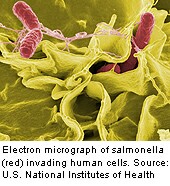
FRIDAY, July 10, 2015 (HealthDay News) — Extreme heat and rainfall are associated with rising rates of salmonella infections, a new study says.
Researchers from the University of Maryland School of Public Health suggest the risk for these infections is likely to grow as climate change increases the number of extreme weather events. They said coastal communities are particularly vulnerable to these food-borne bacterial infections.
“We found that extremely hot days and periods of extreme rainfall are contributing to salmonella infections in Maryland, with the most dramatic impacts being seen in the coastal communities,” Amir Sapkota, an associate professor in the Maryland Institute for Applied Environmental Health, said in a university news release. “As we prepare for the future, we need to take this differential burden into account.”
Salmonella is a group of food- and waterborne bacteria. The germ is often found in uncooked poultry, eggs, beef and unwashed produce. In the United States, salmonella causes an estimated 1.2 million cases each year of severe gastroenteritis, commonly known as the “stomach flu.” Symptoms include diarrhea, fever, vomiting and stomach cramps.
In Maryland alone, more than 9,500 cases of salmonella were reported and confirmed between 2002 and 2012. Previous studies have suggested that weather, particularly temperature and rainfall, plays a role in salmonella infections, the researchers said.
Using three decades of weather data as a baseline, the study’s authors identified extreme heat and rain events from 2002 to 2012. These events were linked to health department data on salmonella infections.
The team of researchers, which included environmental epidemiologists, microbiologists, earth system scientists and officials from the Maryland Department of Health and Mental Hygiene, found there was a higher rate of salmonella infections during summer months than at any other time of year.
The observed risk for this bacterial infection during heat waves was 5.1 percent for people living on the coast, compared to 1.5 percent for people living inland. The risk for these infections during extreme rain was 7.1 percent for coastal residents, compared to 3.6 percent for those in non-coastal areas, the study found.
The study’s authors said their findings suggest public health officials should improve preparedness and response to the health effects of climate change at local, state and national levels.
The study was published recently in the journal Environment International.
More information
The U.S. Centers for Disease Control and Prevention provides more information on Salmonella.
Copyright © 2025 HealthDay. All rights reserved.

